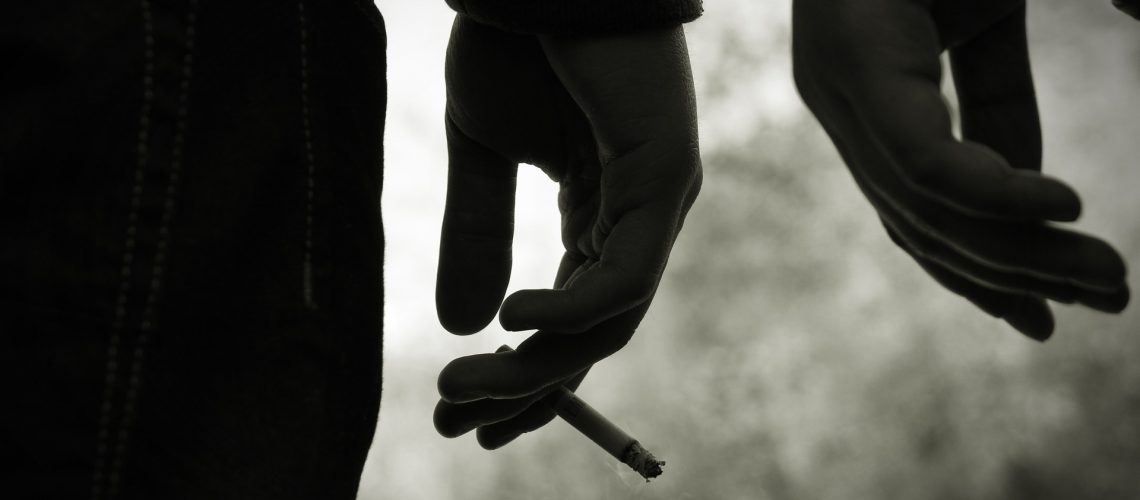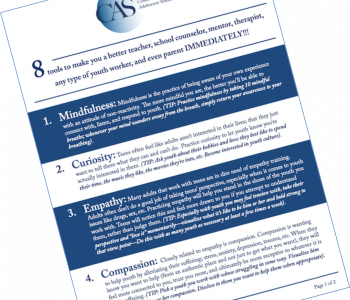

Sam Himelstein, PhD
Sam Himelstein, PhD is the founder of both the Center for Adolescent Studies, and Family Spring, Inc.
The Five Major Types of Drugs Used by Teens
Most of my clients use drugs because they’re self-medicating symptoms of anxiety, depression, trauma, or other emotional or environmental challenges. They don’t understand the negative consequences, or they’ve decided the benefits outweigh the risks. If we’re going to ask teens to stop using drugs, we need to understand the perceived benefits as well as the very real dangers.
Note: The lists and explanations below are non-exhaustive and there are a number of substances not represented in order to focus on highlights and brevity.
Stimulants
This category of drugs includes:
- cocaine;
- MDMA (‘ecstasy’);
- methamphetamine (‘meth’);
- amphetamines, like Adderall;
- methylphenidate (Ritalin); and
- nicotine
Stimulants increase energy and alertness, increase respiration and heart rate, and raise blood pressure. They affect neurotransmitters called monoamines, including norepinephrine and dopamine. Increased dopamine can lead to a feeling of euphoria.
Long-term stimulant abuse can lead to:
- anorexia;
- impaired cognition;
- aggression;
- paranoia; and/or
- hallucinations;
Depressants
Central nervous system (CNS) depressants are sometimes referred to as tranquilizers or sedatives. Because they make users feel calm or drowsy, they are prescribed for sleep disorders or anxiety.
This category of drugs includes alcohol, Xanax and Valium.
CNS depressants work by increasing gamma aminobutyric acid (GABA).
Depressants can be problematic because they cause users to feel sleepy and uncoordinated. Long-term, the body develops tolerance, so it needs increased amounts to achieve the same effects.
Cannabinoids
The dried leaves and buds of the cannabis plant contain both CBD (cannabidiol) and THC (tetrahydrocannabinol).
Cannabinoids can be smoked (joint), vaporized (hookah) or eaten (for example, baked into brownies).
Like opioids, cannabinoids interact with specific receptors in different parts of the central nervous system (CNS), regulating how cells communicate with each other. The endocannabinoid system regulates different types of activities in the body, including sleep, appetite, memory, and mood.
THC triggers dopamine release which leads to a short-term ‘high’ (sensation of pleasant feelings).
Marijuana can have negative impacts on:
- balance and coordination;
- judgment and decision-making;
- learning and memory; and
- motivation
When smoked, marijuana has a similar effect on the lungs as smoking tobacco—this makes users more susceptible to respiratory illness.
Marijuana can lead to laziness and lack of motivation, which can impact schooling and other activities.
Most teens who use marijuana don’t move on to hard drugs, but most youth who do use hard drugs started with marijuana. The true gateway drug is trauma. When marijuana no longer helps as much to manage symptoms, youth may start using harder drugs as a way to cope with those symptoms.
Using cannabis in combination with other drugs can increase the negative effects:
- combining alcohol and cannabis can increase nausea and anxiety or paranoia;
- combining ecstasy and cannabis can lead to issues with memory, motivation, and mental health;
- .some youth use cannabinoids to ‘come down’ from stimulants such as amphetamines and ecstasy. The mixing of cannabis and ecstasy has been linked to reduced motivation, impaired memory and mental health problems.
Opioids
Opioids attach to opioid receptors in the brain, spinal cord, and gastrointestinal tract.
Common opioids include:
- heroin;
- codeine;
- morphine;
- oxycodone (OxyContin, Percocet);
- hydrocodone (Vicodin); and
- meperidine (Demerol)
Opioids works to relieve pain by:
- depressing the central nervous system;
- modifying the brain’s natural opioid receptors; and
- activating a dopamine response, which leads to a feeling of relaxation and euphoria.
Because of the addiction risk, most doctors will only prescribe opioids if a non-opioid medication doesn’t provide sufficient pain relief.
Dangers of long-term use include:
- more likely to overdose; and/or
- severe respiratory depression (stop breathing)
Opioids are even more dangerous when used with other substances that depress the central nervous system.
The most common opioids used by my teen clients are Percocet and “Lean.”
Percocet is a medication prescribed to treat moderate to severe pain, for example while a patient is recovering from surgery. Percocet is popular because it’s easier to obtain than street drugs like heroin. Some teens find Percocet in their family medicine cabinet or get it from a friend. Others become addicted after taking the medication as prescribed while recovering from a sports injury or dental surgery.
Teens may take Percocet by swallowing the tablets, which are sometimes called “percs” or “happy pills.” It’s also common for the pills to be crushed and then snorted, injected, or mixed into a beverage.
“Lean” (so-called because it’s hard to stay upright) is prescription cough syrup (promethazine with codeine). “Lean” is also known by other names including “Purple Drank” and “Syrup.”
In many cases, teens start with marijuana and moved on to Lean in order to self-medicate because their emotional/trauma-response needs weren’t being met, and they’re looking for something stronger.
Hallucinogens
Hallucinogens affect the cerebral cortex (a part of the brain involved in perception, cognition, and mood) and the locus ceruleus (a part of the brain involved in sensory signals). This means that taking hallucinogens can change a person’s perceptions of reality. They may see, hear, or feel something that doesn’t really exist, or they may experience a blending of senses (synesthesia).
Hallucinogens include:
- Lysergic acid diethylamide (LSD): LSD is typically sold in liquid form or applied to paper or sugar cubes. This drug is not addictive, but it can be very dangerous because the effects are so unpredictable, and can include frightening experiences and psychosis (losing touch with reality). In extreme cases, LSD users may injure or kill themselves because they believe they can fly.
- Psilocybin: This is a mushroom that can be eaten, brewed like tea, or added to other foods. Psilocybin use may lead to vomiting, drowsiness, panicking, and/or weak muscles. In large doses it might induce panic or psychosis. There is also a danger of poisoning if the mushrooms have been misidentified.
- Phencyclidine (PCP): This drug is usually sold in a white crystalline powder. It may be snorted, swallowed as a tablet, or smoked (when added to marijuana or an herb like mint or oregano). PCP is addictive and has unpredictable effects. It may cause nausea, dizziness, and blurred vision. It can impact teens’ growth and development. In high doses, it could lead to convulsions or coma.
Conclusion: Calling for a More Nuanced View of Teen Drug Use
There are different reasons why kids use drugs. Not all of them are self-medicating because of trauma, but many of them are. In my therapy practice, this is the number one reason for teen drug use.
If we think of this behavior as self-medicating, it reframes the conversation. We’re not in opposition to the youth; we’re trying to help them with their challenges.
Trauma-informed drug treatment means looking at substance use disorder from a harm-reduction lens. There’s a big reason kids use drugs, whether they’re conscious of it or not. Part of the job of the adult is to help them understand why they’re using drugs, so they can consider healthier alternatives.
Of course I don’t think we should encourage youth to abuse drugs, especially since drugs have a stronger impact on teens because their brains are still developing. I’m just trying to explain what could be going on from their point of view. They’re much more likely to follow our advice if they believe that we understand them, rather than just telling them “Don’t do drugs.”
___
In my 12-session Mindfulness-Based Substance Abuse Treatment (MBSAT) curriculum for youth workers working with teens who use drugs, I dedicate entire sessions to the Mindfulness of Drugs and Health Effects (covered very briefly here!) and dive deep into the Brain, Addiction and Mindfulness. You can learn more and sign up for our next 3-day intensive, virtual training here.
Join the FREE Resilience Community for Helping Professionals to learn more about trauma-informed care, resilience, mindfulness, building relationships, and more! Our community features self-paced courses, a monthly live Zoom call, a weekly live meditation, and an online platform to connect with other providers/professionals in your field.
ADD
Related Posts
3 Tips for Using Mindfulness in Substance Abuse Treatment with Adolescents
3 Ways That Traumatic Events in the Lives of Teens Promote Substance Abuse
Did You Ever Do Drugs? 3 Responses for Adults Who Work with Adolescents

